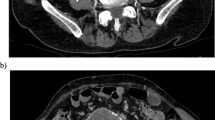Abstract
Purpose
To report safety and effectiveness of type II endoleak embolization, with percutaneous direct aneurysm sac puncture.
Materials and methods
Fifty patients, 31 male (mean age 55 ± 5), with post-EVAR type-II endoleak underwent direct percutaneous sac puncture for embolization. Procedures were performed, under local anesthesia. Sac puncture was done using a 20G needle under rotational angiography guidance. A coaxial system (4 Fr catheter + 2.7 microcatheter) was used to navigate the sac. During the follow-up period, all patients underwent contrast-enhanced ultrasound (CEUS) at 6 and 12 months.
Results
Technical success, with complete exclusion of the aneurysm sac, was achieved in all cases. Time of procedure varied between 36 and 68 min (mean 51.36 min). Mean fluoroscopy time was 16.7 min. A posterior left access was used in 41 cases, posterior right access in 6 cases, and an anterior approach in 3. In 19 cases (38%), one or more feeding vessels were visualized and embolized. Sac embolization was done using Onyx plus micro-coils in 31 cases (62%) and Onyx alone in 19 cases (38%). Mean amount of Onyx was 6 ml. No complications, correlated with the direct percutaneous sac puncture, or to Onyx injection occurred. After 1-year follow-up, sac shrinkage occurred in 34 cases (68%), while in 16 patients (32%) sac size remained stable without evidence of sac perfusion.
Conclusion
Percutaneous direct sac embolization using Onyx in combination or not with microcoils represents a safe and valid technique to solve post-EVAR type II endoleaks.

Similar content being viewed by others
References
Chaikof EL, Dalman RL, Eskandari MK et al (2018) The Society for Vascular Surgery practice guidelines on the care of patients with an abdominal aortic aneurysm. J Vasc Surg 67:2–77.e2. https://doi.org/10.1016/j.jvs.2017.10.044
Ultee KHJ, Büttner S, Huurman R et al (2018) Editor's choice—systematic review and meta-analysis of the outcome of treatment for type II endoleak following endovascular aneurysm repair. Eur J Vasc Endovasc Surg 56:794–807. https://doi.org/10.1016/j.ejvs.2018.06.009
Rand T, Uberoi R, Cil B et al (2013) Quality improvement guidelines for imaging detection and treatment of endoleaks following endovascular aneurysm repair (EVAR). Cardiovasc Intervent Radiol 36:35–45. https://doi.org/10.1007/s00270-012-0439-4
Bryce Y, Lam CK, Ganguli S et al (2018) Step-by-step approach to management of type II endoleaks. Tech Vasc Interv Radiol 21:188–195. https://doi.org/10.1053/j.tvir.2018.06.009
Spanos K, Tsilimparis N, Larena-Avellaneda A et al (2017) Systematic review of laparoscopic ligation of inferior mesenteric artery for the treatment of type II endoleak after endovascular aortic aneurysm repair. J Vasc Surg 66:1878–1884
Sidloff DA, Gokani V, Stather PW et al (2014) Type II endoleak: conservative management is a safe strategy. Eur J Vasc Endovasc Surg 48:391–399. https://doi.org/10.1016/j.ejvs.2014.06.035
Otsu M, Ishizaka T, Watanabe M et al (2016) Analysis of anatomical risk factors for persistent type II endoleaks following endovascular abdominal aortic aneurysm repair using CT angiography. Surg Today 46(1):48–55
Sidloff DA, Stather PW, Choke E et al (2013) Type II endoleak after endovascular aneurysm repair. Br J Surg 100:1262–1270
Cannavale A, Lucatelli P, Corona M et al (2020) Evolving concepts and management of endoleaks after endovascular aneurysm repair: where do we stand in 2019? Clin Radiol 75:169–178. https://doi.org/10.1016/j.crad.2019.10.023
Wanhainen A, Verzini F, Van Herzeele I et al (2019) Editor's choice—European Society for Vascular Surgery (ESVS) 2019 clinical practice guidelines on the management of abdominal aorto-iliac artery aneurysms. Eur J Vasc Endovasc Surg 57:8–93
Coppi G, Saitta G, Coppi G et al (2014) Transealing: a novel and simple technique for embolization of type 2 endoleaks through direct sac access from the distal stent-graft landing zone. Eur J Vasc Endovasc Surg 47:394–401
Katahashi K, Sano M, Takehara Y et al (2019) Flow dynamics of type II endoleaks can determine sac expansion after endovascular aneurysm repair using four-dimensional flow-sensitive magnetic resonance imaging analysis. J Vasc Surg 70:107–116.e1
Rhee R, Oderich G, Hertault A et al (2019) Multicenter experience in translumbar type II endoleak treatment in the hybrid room with needle trajectory planning and fusion guidance. J Vasc Surg S0741-5214(19):32626-6. https://doi.org/10.1016/j.jvs.2019.10.076
Uthoff H, Katzen BT, Gandhi R et al (2012) Direct percutaneous sac injection for postoperative endoleak treatment after endovascular aortic aneurysm repair. J Vasc Surg 56:965–972
Ierardi AM, Micieli C, Angileri SA et al (2017) Ethylene-vinyl alcohol copolymer as embolic agent for treatment of type II endoleak: our experience. Radiol Med 122:154–159
Müller-Wille R, Wohlgemuth WA, Heiss P et al (2013) Transarterial embolization of type II endoleaks after EVAR: the role of ethylene vinyl alcohol copolymer (Onyx). Cardiovasc Intervent Radiol 36:1288–1295
Faccioli N, Foti G, Casagranda G, Santi E, D'Onofrio M (2018) CEUS versus CT angiography in the follow-up of abdominal aortic endoprostheses: diagnostic accuracy and activity-based cost analysis. Radiol Med 123:904–909. https://doi.org/10.1007/s11547-018-0926-z
Author information
Authors and Affiliations
Corresponding author
Ethics declarations
Conflict of interest
The authors declare that they have no potential conflict of interest.
Ethical approval
This is a prospective clinical study involving patients.
Informed consent
Informed consent was collected from all patients included in this study.
Additional information
Publisher's Note
Springer Nature remains neutral with regard to jurisdictional claims in published maps and institutional affiliations.
Rights and permissions
About this article
Cite this article
Fanelli, F., Cannavale, A., Chisci, E. et al. Direct percutaneous embolization of aneurysm sac: a safe and effective procedure to treat post-EVAR type II endoleaks. Radiol med 126, 258–263 (2021). https://doi.org/10.1007/s11547-020-01247-2
Received:
Accepted:
Published:
Issue Date:
DOI: https://doi.org/10.1007/s11547-020-01247-2




